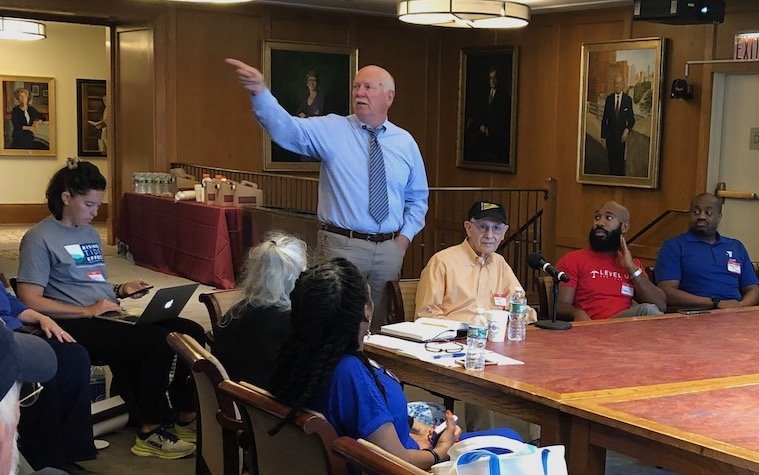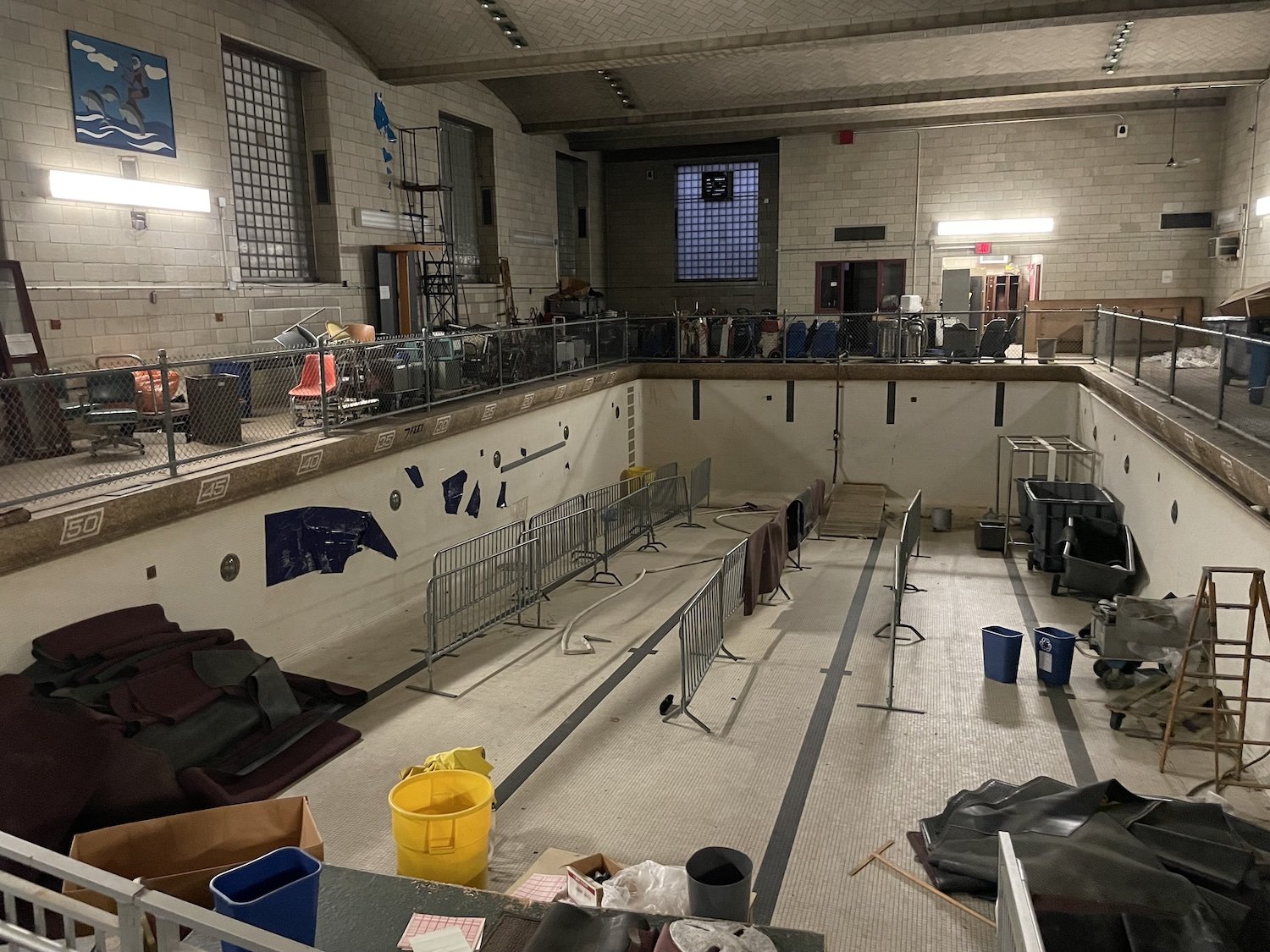Comments by Carl Quigley to the New York State Water Safety Commission
Carl Quigley at NYC Aquatics Symposium. Photo: M. Randazzo
Editor’s Note: last October, Janet Fash, one of New York City’s most experienced lifeguards, and Carl Quigley, a long-time water polo coach and aquatics director for St. Francis College, Brooklyn, spoke with members of the NYS Water Safety Commission. Following are Quigley’s comments regarding his life in New York City aquatics and his suggestions on to how best to improve our city’s aquatics culture.
I've been involved with aquatics my whole life. It's about 60 years; first as a boy scout then as a high school swimmer in New York, a Division I collegiate swimmer, water polo player, swim coach and water polo coach. I have a master’s degree from Long Island University—my mentor was Gene Spatz who started a program called On Your Mark on Staten Island. We worked with senior citizens, children and people of all disabilities, setting up aquatic programs for them.
My life in aquatics has been a joy, but from my standpoint we were always fighting each other for the same athlete or pool time; whether non-profit or for-profit. Lots of times the win went to the highest bidder or the best organized group rather than the best clinicians.
Last summer we brought together the New York City aquatic community in a symposium at Brooklyn Law School [NYC Aquatics Symposium]. What I found there were superb clinicians and very organized groups doing good things in the water. One such person is Kate Kraus of Rising Tide Effect. I know Kate and was moved by her presentation about getting at-risk children to learn swimming at a Far Rockaway hotel.
Kate Krause at NYC Aquatics Symposium
The symposium covered many of the challenges running aquatic programs in our city: liability coverage, lifeguarding, staffing, getting people to and from the pool. We all want to bring young individuals together and place them in an environment where they're able to learn and to give back. Ten years down the road, they might become a swimmer or a lifeguard or a coach.
We all depend on the people we develop; several organizations affiliated with St. Francis hired our swimmers as instructors and lifeguards.
We also want to facilitate aquatic opportunities for diverse communities. One of the best things we did at St. Francis was when the wounded warriors come in and swam, such as veterans who took weekend scuba lessons. If you take in the picture of the gentlemen you see a disabled person in a weightless environment who has freedom of movement. This still gives me goosebumps.
To continue to make progress, we need hard data about available facilities especially those owned by the city. Many of the Robert Moses-built pools are in disrepair, some from usage, some from old age—don’t forget these pools were built almost 90 years ago.
Equally important is the management of those venues. If you don't have someone with a broad perspective and knowledge of how to run and organize a facility it can fail in a heartbeat—and won’t provide the swim opportunities that it should.
There’s also pools in NYC public schools. Last August Mike Randazzo, I and two gentlemen from Myrtha Pools scheduled appointments to see four of these pools—two in Brooklyn, two in Manhattan. Our goal was to see what conditions were for select pools in schools. I don't know if you're familiar with Myrtha; they’re one of the world’s biggest pool manufacturers.
At the last minute we were shut out of the DOE visits because of unexpected roadblocks.
When we were shut out I suggested we go to Brooklyn College. I grew up by Brooklyn College, and in my lifetime there’s been three pools at the college. One was the Roosevelt Pool. After that was the Plaza Pool and after that was a new pool—a beautiful facility. It’s an eight lane, 25 yard pool shallow / deep handicap accessible, everything you’d want in an urban pool.
As I came to the entrance on Bedford Avenue, I remembered that years ago there was a pool I used to swim in, right across the quadrangle (in Roosevelt Hall). We met a maintenance person who offered to help—she pushed open a door, we walked through the women's locker room and on to the deck of a four-lane, 25 yard pool that probably hadn't been opens since 1970.
Recent picture of Roosevelt Pool at Brooklyn College. Photo: C. Quigley
The Myrtha people said all that’s needed is to reline the pool, turn the lights on, fill it with water, check the filters—and then kids from local public schools in school could get swim lessons on a CUNY campus! I don't know if Brooklyn College has plans for the building, but after 50 years maybe they could find a way to utilize that space.
Pop-up pool in basin of Robert Moses-era facilities
We should also look to the Robert Moses/WPA era pools throughout the city to get more people in the water. There are eleven; they're gigantic and located in every borough. A simple solution—and I credit Shawn Slevin of Swim Strong Foundation because she suggests that climate change is affecting NYC residents’ access to water—is to extend the outdoor pool season because of warmer temperatures. The fact that these outdoor pools are only open for at most 12 weeks, depending on summer holidays, is a problem.
One Moses-era pool pictured here is at the Red Hook Recreation Center in Brooklyn. It’s a tremendous pool and if we can manage the city lifeguard situation past September—when outdoor city pools close— and have select Moses pools open from April until November, it will greatly increase recreational space for the general public. And improve NYC’s swimming culture. To do this you will need warm covers or even a heating system, but it's an achievable fix on city property.
Basin at Red Hook Recreation Center—off season. Photo: C. Quigley
Another idea is to build a temporary pool at that same facility, a Myrtha Pool like what’s used for world or national championships. They fill a stadium, like Barclay Center, with thousands of people for high-level swim meets. You could put up a temporary pool at an existing site owned by the city—managed by NYC Parks or another not for profit—cover it with a bubble and keep it open year round as a competitive site for youngsters to learn to swim or to compete.
This photograph shows a Myrtha Pool owned by David Ferris in Long Island. He bought it years ago and had it in storage until he was able to work out a deal with Nassau County. They gave him land that connects directly to the Nassau Aquatic Center, the former site of the Goodwill Games as well as several national aquatics championships.
An interesting thing is within a square mile of this pool—50 meters long, 25 yards wide—there’s four Olympic-size facilities. There’s a 50-meter pool next door. At nearby Nassau Community College there’s a 25-yard, eight-lane pool with a diving well. And Hofstra University has a 50-meter, 25 yard pool.
Myrtha Pool installed at Nassau County Aquatics Center. Photo: C. Quigley
There's feast— the people of Nassau County have great swimming choices for them/their kids—and famine: New York City, with almost nine millions people, has only has three 50-meter pools. One in the Bronx (Lehman College) one in Queens (Flushing Meadows) and one in Manhattan (Asphalt Green).
To get more pools we must enlist New York City elected officials and local corporations and attract big time swimming competitions, with local Olympians who grew up here—and suffered—leading the way.
Wolf Wigo. Photo: Dawn Young
I’ll give you an example. A young man I coached years ago was a swimmer for Bronx Science High School. His parents were divorced. He lived part-time with his dad in New Jersey and his mom in Manhattan. He would train in water polo for me at St. Francis three times a week, then played with the men at New York Athletic Club. He got a scholarship to Stanford, was a four-time All-American, two-time NCAA water polo champion, and captain. He made the US Olympic team where he was a four-time Olympian and two-time captain.
Wolf Wigo is the greatest water polo player New York City has ever produced—accomplished under dire circumstances.
You have Michael Phelps with a learn-to-swim program in Buffalo. Here, we have to build a facility, one that could attract national and international events. The excitement that you'd get from this is off the charts. I remember when Adrian Benepe, Mayor Michael Bloomberg’s Park Commissioner, tried to bring the 2020 Olympics here back at the turn of the century. The bid failed, but it would be great if Olympians will help us attract tournaments, competitions and clinics.
The Empire State Games
I was an organizer for the Empire State Games and—because this is the statewide commission—I mention it because it was one of the most beautiful things for young people and coaches I was ever affiliated with.
The state was divided into 5 - 6 regions. You’d pick the best athletes from each region and bring them to a central location every summer for a week. The competition was great. But what was even better was the goal: Get these kids to represent their division, from New York City to the Hudson Valley, to Long Island, to central Adirondack… I'm going to miss somebody.
They lived as college students, with an ID card and a weekend stay in a dormitory. There was good coaching, good competition, meals and a bus ride up and home.
Empire State Winter Games open in Lake Placid, 2014
Syracuse benefited from it. Cortland had it twice. Buffalo had it; Long Island had it too. They all vied for this event because of the money it brought into each community. They got funding through the New York State lottery as well as from private corporations.
To give you a sense of the scale, we brought all the athletes together and marched them into a stadium to open the games; one time it was the Carrier Dome in Syracuse. There was a performer for a rock concert. And the kids marched in in front of their families to rousing applause.
It’s amazing this happened—and it makes me so sad that we lost it. These are things I think that this group might be able to help facilitate. Because it was in play for 25 years, and it was the largest Olympic style competition outside the Olympics.








